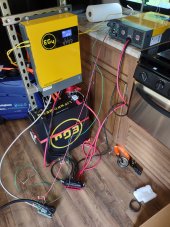I have an EG4 3kw inverter and a single lifepower4 battery. It runs as a backup for the networking equipment in the house with a steady 500w load. We had the opportunity to borrow a travel trailer and I wanted to be able to have the AC after "generator hours" are over. So I dismantled the setup in the house and attached it to a hand truck to put into the trailer.
However, it won't run the AC. The battery goes into fault and the inverter reboots. I tried the firmware update that EG4 put out (the one with the lousy attitude in the video) and successfully updated it. Now it doesn't go into fault but it does restart. No error on the inverter that I could see. The battery specs clearly indicate that it's capable of 100a output, with 30 recommended. I just don't see more than 30a output.
My little Honda will start it, if Eco mode is off, so the surge isn't much more than 2000w. The generator doesn't even go into overload to do it.
Components:
12,500 BTU AC from 2019
Travel trailer with 30a input wiring
Honda EU2000i generator with 2000w surge, 1600w rated
LifePower4 5kwh battery 48v
EG4 3kw inverter
I'm sure adding another battery would be all the difference, but this is a temporary setup just needed through the end of the week. It's just frustrating to not get anywhere near the rated power out of the unit.
Any ideas for how to get this working?
However, it won't run the AC. The battery goes into fault and the inverter reboots. I tried the firmware update that EG4 put out (the one with the lousy attitude in the video) and successfully updated it. Now it doesn't go into fault but it does restart. No error on the inverter that I could see. The battery specs clearly indicate that it's capable of 100a output, with 30 recommended. I just don't see more than 30a output.
My little Honda will start it, if Eco mode is off, so the surge isn't much more than 2000w. The generator doesn't even go into overload to do it.
Components:
12,500 BTU AC from 2019
Travel trailer with 30a input wiring
Honda EU2000i generator with 2000w surge, 1600w rated
LifePower4 5kwh battery 48v
EG4 3kw inverter
I'm sure adding another battery would be all the difference, but this is a temporary setup just needed through the end of the week. It's just frustrating to not get anywhere near the rated power out of the unit.
Any ideas for how to get this working?



